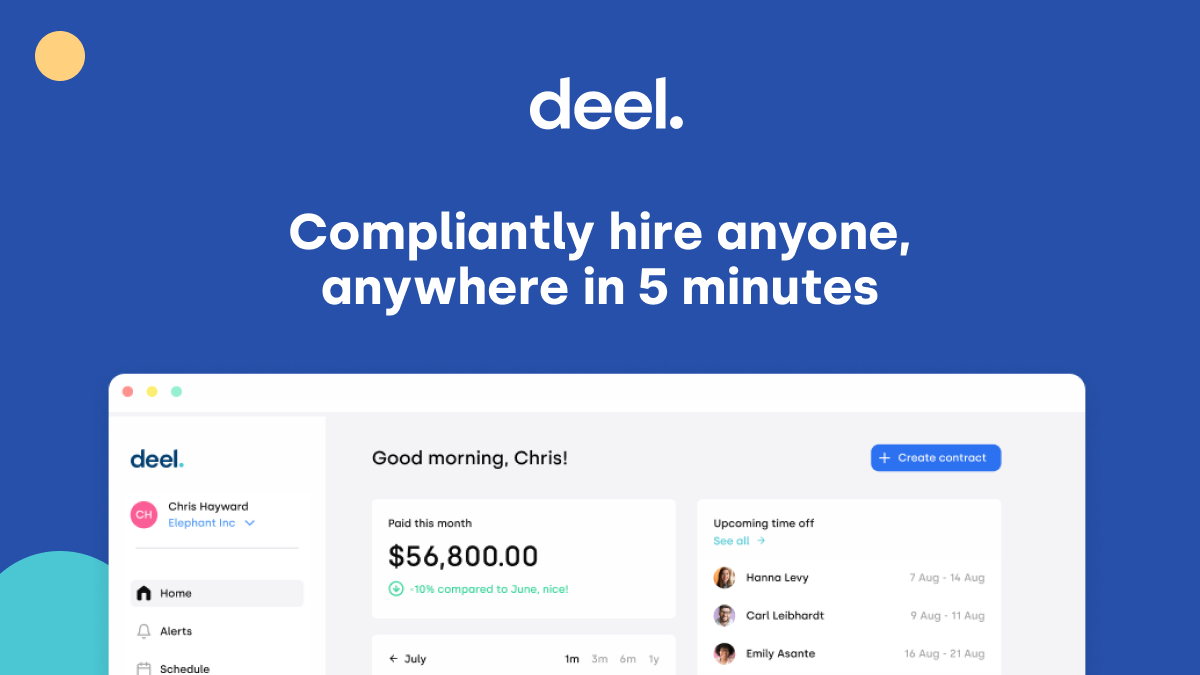Deel, the world’s leading all-in-one HR platform, recently held its Annual Global Hiring Summit. The summit brought together thought leaders and industry experts at the intersection of global talent acquisition and global remote work (GRW). The event occurred amid a tight US labor market and the ongoing WFH/RTO debate. Additionally, global tech and financial sector layoffs, de-dollarization, and nearshoring and friendshoring trends figured prominently in the summit. More importantly, the Deel Global Hiring Summit addressed regulatory challenges in onboarding global remote workers and legal risks for SMEs. Panelists also tackled the risk and promise of artificial intelligence in talent acquisition and the hiring process. In this blog post, we’ll briefly discuss Deel, our key takeaways from the summit, and future trends impacting global remote work.
Who is Deel?
Deel, a leader in global workforce management, offers innovative solutions that revolutionize how businesses manage their HR processes. The company offers comprehensive tools for managing and expanding a workforce across borders. In an era where remote work and global teams are becoming the norm, Deel’s all-in-one HR platform is a leader in efficiency and reliability. The company ranks as the leading integrated global HR platform offering everything needed to scale global teams. Core offerings from Deel include:
- Deel Global Payroll: Deel’s global payroll platform combines HR compliance, managed payroll, and workforce management for contractors worldwide. With Deel, you can pay international teams in 90 countries.
- US PEO and Payroll: With Deel US PEO and Payroll, employers can manage payroll, benefits, and HR for US teams. Companies can run payroll in minutes, reducing data errors and allowing them to compete more effectively for top talent.
- Employer of Record: Deel’s EOR service removes the hiring headaches, allowing companies to enter over 100 countries and onboard talent without setting up a local business entity.
Deel Global Hiring Summit Insights
Deel’s Annual Global Hiring Summit brought together speakers at the intersection of global talent acquisition and remote work. They addressed current themes related to global talent acquisition, including the state of global hiring, key risks in onboarding global talent, and data security. A panel discussion on the role of AI, its risks, and its benefits in global talent acquisition offered ideas for talent acquisition leaders and hiring managers to streamline their processes.
Global Hiring Headwinds in 2022 – Optimism in 2023
Deel offered insights from their database of over 500,000 contracts from more than 30,000 companies. According to Deel, in 2022, the market witnessed strong headwinds as terminations rose and sectors such as software and engineering experienced salary reductions. However, during the same period, roles for ops and finance witnessed modest salary increases.
Despite the headwinds experienced in 2022, some optimistic signs of recovery continue to emerge in 2023. Specifically, terminations continued to slow, and hiring in sectors such as AI and AI adjacent roles witnessed robust growth. According to Deel insights, hiring for AI and AI adjacent roles grew more than 800% over the past two years in line with the emergence of Chat GPT. Additionally, the key markets for remote workers continued to evolve as Bangalore replaced San Francisco as one of the top cities for remote workers. With global hiring continuing at sustained levels, it appears that global remote work is here to stay.
Key Takeaway: Global hiring is a sustained trend.
ClearSky 2100 Ventures

Creating an Exceptional Employee Onboarding Experience – Mario Espindola @ Signal Labs
According to Mario Espindola from Signal Labs, ensuring a great onboarding experience is essential in the highly competitive market for global talent. Mr. Espindola stated that the onboarding experience is key to building the throughput and bridge from the candidate interview into the organization. Having a structured process can lead to stronger employee commitment and productivity. He cited the following stat.
“Onboarding Helps New Hires Feel 18x More Committed to Their Employer“
Signal Labs, Bamboo HR
According to Mr. Espindola, building an effective onboarding program need not be complex. Don’t over-engineer the program. He laid out a useful framework for structuring onboarding programs. It’s a model applicable to both start-ups and larger organizations. It requires three core elements to create an exceptional onboarding experience. These include:
- Set role alignment and performance expectations: He suggested setting 30,60,90-day check-ins. It’s also important to clearly communicate performance expectations relative to the role.
- Align the new hire with culture and team: Build authentic ways of interaction, he argued. Spend time getting to know the new hire and determine preferred communication methods. Also, set meeting agendas for your new employees to introduce them to other relevant organizational stakeholders.
- Emphasize learning, logistics, and compliance: Ensure new employees can access the systems, training, and employee manuals easily. Other programs such as insurance, health care, and additional benefits should be made known to the new hire early on.
Making the initial investment will lead to higher (62%) productivity and higher (50%) retention.
Key Takeaway: Focus on the onbaording framework but don’t over engineer the program.
ClearSky 2100 Ventures
Global Work Isn’t Really a Thing – Samuel Dahan @ Deel Labs
Samual Dahan, Head of Deel Labs, offered interesting insights on the state of global hiring from Deel’s perspective. Also, he weighed into the WFH/RTO debate as it related to worker productivity while challenging the current legal framework of global work. Additionally, he highlighted exciting innovations happening at Deel Labs, providing a sneak preview of emerging technologies launching in the coming months.
Is GRW Here to Stay?
Mr. Dahan challenged the view of many employers who believe remote work is sub-optimal. He admitted that while some studies did show some negative impact of full remote workers on mentoring and innovation, it was important to take a macro view and focus more on worker productivity. Pointing to data from the National Bureau of Economic Research, he noted that worker productivity has increased since 2020, suggesting that WFH has not negatively impacted worker productivity.
More broadly, he noted that the data presented in many studies was too anecdotal and insufficient to draw a definitive conclusion. However, WFH has been immaterial when focusing on financial performance and revenue growth.

Regulatory Challenges with Remote Work
Aside from WFH issues, Mr. Dahan felt there were more pressing concerns, namely weakness in the regulatory framework for global remote work. Global work isn’t really a thing, noted Mr. Dahan, suggesting that work was never really globalized save for a few sectors, e.g., finance and capital markets. Moreover, only multinationals possessed the human resource infrastructure to tap and onboard a global workforce. SMEs and small businesses were disadvantaged due to limited resources and infrastructure, increasing the risk of miscalculation. Given the disparate policy and legal frameworks for global work across countries, the risk of misclassification wasn’t the only risk businesses needed to mitigate regarding independent contractors. Other concerns included:
- Social Security and Benefits
- Income Tax and Payroll
- Corporate Tax: Risk of Double Taxation
- Immigration
- Data Security
Innovation at Deel
Misclassification risk remains top of mind for the team at Deel. Deel’s EOR market-leading capabilities already support the many companies seeking to onboard globally without setting up a legal entity. However, to further address this pain point, the company developed an AI-based platform to assess worker classification accurately. Key advantages of the platform include:
- High Predicative Capabilities: 94% accuracy in identifying worker classifications.
- Regulatory Compatibility: An algorithmic model in line with judicial interpretation across markets
- Future Proof: Continuously updating in line with evolving labor frameworks worldwide.
The system is currently under testing in the US and Canada and will roll out to over 100 countries by 1st Q 2024.
Key Takeaway: Regulatory inefficiencies with global remote work are being addressed through innovation.
ClearSky 2100 Ventures
Avoiding Pitfalls in Global Compensation Design – Stephanie Tignor @ Pave
Stephanie Tignor, Head of Data at Pave, the world’s largest compensation provider, highlighted some of the core challenges companies face in building a global compensation strategy. Pave’s insights reflect data from 1 million employee records across 42 countries and 6,200 companies.
Fair and transparent pay practices are key to retaining and keeping key global talent, particularly in a rapidly evolving global talent market. However, many companies fail to build an effective global compensation strategy. Based on Pave’s data, she highlighted three key pitfalls employers experience. These were:
- Paying one rate globally: Risk in overpaying or underpaying in certain locations, which can lead to attrition or loss of talent to competitors.
- Localizing global compensation with cost of living: Many employers conflate cost of living and cost of labor. There is a difference. Additionally, cost of labor is not directly correlated with the cost of living. Not understanding the difference risks of overpaying or underpaying for global talent. She highlighted examples of San Francisco vs Switzerland and San Fransico vs. Sao Paulo.
- Not accounting for currency fluctuations: Using static or outdated currency rates. Pave recommends using a window and calculating a rolling average e.g., 30 days. This number should be updated frequently. In addition, Pave notes that companies also need to monitor global market movements, e.g., growth rates between emerging and mature markets. They’ve seen differences of 7-10% in emerging markets and 2-4% in mature markets.
Pave also shared the latest in global compensation trends. For example,
- The best markets for highly qualified (strong technical talent) and cost-effective talent:
- United States (Chicago, Salt Lake City, Pittsburgh)
- International (India, China, Poland, and Bulgaria)
- Markets where salaries (P3 software engineers) are increasing too rapidly to stay competitive: Austin and Atlanta in the US, Belgium, and Ireland Internationally. In these markets, the perception and reality of lower labor cost no longer exist.
- The least affordable international markets by role included:
- Singapore, Switzerland, and Denmark for software engineers.
- Switzerland, Israel, and Singapore for go-to-market roles (e.g., product, customer success, etc.)
Key Takeaway: Don’t set it and forget it, monitor global compensation programs frequently and adjust when needed.
ClearSky 2100 Ventures
AI and Talent Acquisition – Reclaiming Time and Improving Cognitive Cycles: Panel Discussion
The final discussion at the Deel Annual Global Hiring Summit featured hiring managers and talent acquisition leaders from various companies, including Metaview, Intrinsic, Lilt, and Render. Generally, recent discussions of AI continue to focus on job replacement. However, this panel discussion dealt with the pros and cons of AI for hiring managers. There was broad consensus among the panelists that while AI added some value, hiring will forever remain a human affair. The panel discussion centered on the following themes:
- Impact of AI on the day-to-day activities of recruiters
- Balancing the human element with AI
- Risks of AI in Recruitment and Talent Acquisition
- Value of bringing AI into the hiring process
- Use of AI by candidates
- Dealing with internal resistance to AI.
Impact on Day-to-Day Recruitment Activities
Many of the panelists saw the benefits of using AI to reduce workload, particularly around mundane tasks. Saidhal Magos CEO of Metaview noted that AI in its current state could automate many of these mundane tasks, such as note-taking, summarizing, sourcing, initial screening, etc. This would allow recruiters to focus more on the human interaction with candidates.
Balancing the Human Element with AI
A major frustration voiced by the panelists related to the issues of ghosting on both sides, the candidate and the company. The panelists shared their experiences with this issue, noting the negative impact on personal branding and company reputation. Recruiters could leverage AI to automate responses, ensuring constant communication throughout the recruitment process.

The Risk of AI in Recruitment and Talent Acquisition
All the panelists saw the benefits of AI while noting some of the risks. Of note was a major risk of too much reliance on AI in recruitment. They also highlighted the issue of accountability, suggesting that it lacked clarity in the context of AI. Additionally, the risk of bias was something that needed to be paid attention to. While AI could generate job descriptions, overreliance on the output could lead to bias. The risk of bias was real.
Tianna Johnson, Head of Talent Acquisition at Render, suggested that recruitment was akin to the art of matchmaking. As such, it required humans to be part of the process at many of the stages. While AI may be good at pattern matching and indexing, argued some on the panel, it lacks the capabilities to understand the intricacies of a company’s culture. Ultimately, only the human element could cut through the noise to better understand the candidate’s story, noted Jason Gingrich, Head of Talent Acquisition Lead at Intrinsic.
Benefits of AI in the Candidate Process
For the panelists, they saw AI as an opportunity to source candidates at scale with deeper insights. Gwinevere Crary, VP of Global People Ops, noted that AI has allowed her to recruit 10x faster based on recent experience. Additionally, AI allows hiring managers to realize a significant productivity bump. With this productivity bump, recruiters could reclaim their time and improve cognitive cycles. Tianna Johnson from Render saw a massive productivity bump in content creation based on her experience. She noted that she was a hiring manager, not a content creator. However, AI has allowed recruitment managers to significantly reduce the time in content creation for presentations and campaigns while eliminating reliance on relevant internal or external stakeholders, e.g., graphic designers.
Candidate Use of AI in the Application Process
The panelists expressed a bullish view on using AI from a candidate’s perspective, e.g., interviews and the application processes. Jason Gingrich noted that candidates who could harness AI tools to move quickly or better articulate their advantage were in a good position. However, he noted that using AI to generate answers and interpreting output were two different issues. The ability for candidates to do both indicated better problem-solving capabilities. One interesting observation related to candidate assessment design by employers. Saidhal Magos felt that companies would need to revisit their corporate values as cookie-cutter corporate values could lead to candidate manipulation. Companies need to articulate their true corporate values better to optimize candidate matching.
Team Resistance to Adopting Data-Driven Approaches
The accent and use of AI did cause fear among some teams. According to the panelists, it was important to understand the fear and develop strategies to bring teams along. Tianna Johnson from Render noted that AI was happening whether we liked it or not, and embracing it was necessary to grow and thrive. However, she did note that while AI was good at data, content, etc., it could not add value in the last mile of the candidate acquisition process, e.g., closing. Selling was one of the most important elements of the pipeline, which required relationships and connections. Only people could achieve this.
AI did give hiring managers and talent acquisition teams the productivity lift they were looking for. However, in the current iteration of AI post-Chat GPT, one of the benefits is user adaptability. The flexibility and adaptability will enable people to do more things than ever before. However, it’s important to understand that hiring was not just about filling roles but being a partner and advisor to building best-in-class teams.
Key Takeaway: AI in global talent acquisition is a positive trend. However, overreliance and bias present real downside risks.
ClearSky 2100 Ventures
To learn more about Deel and the advantages they can bring to your organization, book a demo with the sales team. For more information on ClearSky 2100 Ventures and our work, please contact us. Also, be sure to follow us on LinkedIn.
Disclosure: At ClearSky 2100, our portfolio partly consists of affiliate partnerships. We may earn a small commission from buying links on our site at no cost to you.







